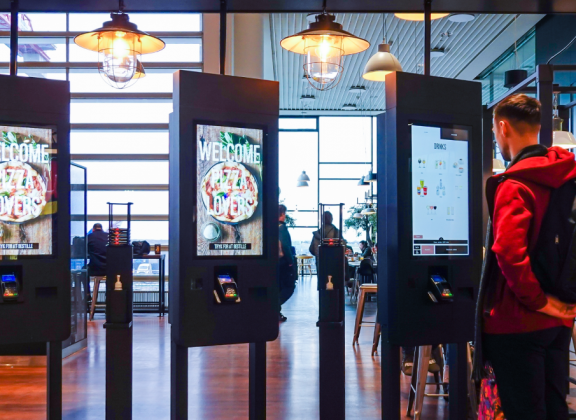As consumer expectations evolve and attention spans shrink, businesses must explore more dynamic and efficient ways to communicate visually. Digital signage, powered by IPTV (Internet Protocol Television), is proving to be a powerful ally in this transformation. From restaurant menus to retail window displays and immersive video walls, IPTV brings unprecedented agility and impact to visual content delivery. It empowers brands to control, customize, and scale content across multiple locations in real time, all through internet-based streaming technology.
This article explores how IPTV is redefining the use of screens in commercial environments, turning them from static displays into intelligent tools for engagement, branding, and real-time information.
The Rise of IPTV in the Visual Communication Landscape
The shift from analog signage to digital systems is not just a trend—it’s a strategic evolution. IPTV allows video content to be distributed over IP networks, bypassing traditional broadcasting methods. This approach provides centralized control, enabling businesses to manage a fleet of screens across cities or countries from a single dashboard.
In hospitality, retail, and food service sectors, where fast-paced changes in offerings and promotions are the norm, IPTV helps keep content accurate, up-to-date, and visually compelling. It reduces reliance on manual updates and print materials, creating an environment where content is always fresh and contextually relevant.
Revolutionizing Food and Beverage Displays with IPTV
Restaurants and cafes are among the primary beneficiaries of IPTV-based signage. Digital menu boards powered by IPTV give food establishments the ability to switch menus based on time, location, or customer demand—instantly and remotely. Morning breakfast offerings can seamlessly transition into lunch specials without staff intervention.
More than just functional, these displays become experiential. High-definition video loops of signature dishes being prepared, animations highlighting limited-time offers, or calorie and allergen information layered into the design can significantly improve customer satisfaction and decision-making. For chains and franchises, maintaining consistency in menu presentation across all locations becomes effortless with IPTV infrastructure.
Dynamic Retail Messaging with Screen-Based Storytelling
In the competitive retail environment, attracting passerby attention and increasing in-store conversions often depends on the strength of visual storytelling. IPTV enables retailers to deliver curated multimedia content through digital displays positioned in windows, near entrances, and throughout the store.
Instead of relying on static posters, brands can broadcast targeted video content—product features, influencer endorsements, seasonal campaigns, or behind-the-scenes footage—on a loop or timed schedule. This dynamic presentation responds better to customer psychology and creates a sense of urgency or desire. Furthermore, content can be tailored to different locations or demographics, ensuring relevance and resonance with local audiences.
Video Walls as Experiential Hubs
Video walls, once reserved for high-budget installations, are now accessible tools for immersive branding thanks to IPTV. In retail flagships, automotive showrooms, corporate headquarters, and entertainment venues, large-format displays offer a way to make a bold statement.
These walls act as digital canvases, seamlessly synchronized through IPTV systems. They can play brand documentaries, live streams, data visualizations, or promotional montages. The modular nature of IPTV allows for precise control over every screen tile—meaning businesses can manipulate each section of a video wall independently or in harmony, depending on their creative vision.
Whether used for brand storytelling or real-time interactivity, video walls deliver a premium experience that builds emotional connections with viewers and elevates the space.
Operational Advantages That Go Beyond Display Quality
IPTV is not just about vibrant visuals—it also delivers significant back-end benefits for business operations. The reliability of modern IPTV systems means reduced downtime and fewer maintenance headaches. Content can be updated remotely, scheduled in advance, or interrupted for live broadcasts when needed.
Security is a critical concern for digital infrastructure, and IPTV addresses this with secure login protocols, user roles, and encrypted data transmission. This ensures that sensitive content—such as pricing, announcements, or internal communication—remains under control.
Scalability is another vital benefit. As businesses grow or expand into new markets, they can extend their IPTV systems with minimal technical friction. Adding new screens or regions doesn’t require a complete overhaul—just integration into the existing framework. This helps businesses remain agile and responsive in a fast-changing market.
Smart Hardware Choices for Seamless Content Delivery
At the heart of any IPTV setup are the hardware components that bridge the content management system and the physical display. Modern media players and IPTV set-top boxes are designed for seamless connectivity, stability, and high-quality playback.
Equipped with robust processors, 4K support, and remote management features, today’s media players make it easy to deploy content-rich experiences in any location. Their compact form factor and efficient cooling also make them ideal for tight spaces or hidden installations.
Choosing the right hardware ensures smooth transitions, minimal latency, and high compatibility with various content types and formats. With an appropriate device, businesses can turn any screen—LED, LCD, or OLED—into a smart, programmable marketing asset.
IPTV has emerged as a cornerstone technology in modern digital signage, transforming how businesses present menus, advertise products, and create immersive environments. Its real-time flexibility, centralized control, and scalable infrastructure make it ideal for any enterprise seeking to enhance customer engagement and brand presence.
Whether you’re updating a single restaurant menu, running coordinated campaigns across retail chains, or installing large-scale video walls for immersive experiences, IPTV provides the tools and reliability to deliver impactful visual communication at scale. For any business serious about visual strategy, IPTV is not just a display solution—it’s a competitive advantage.
